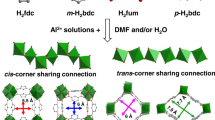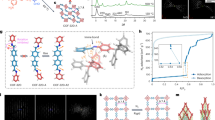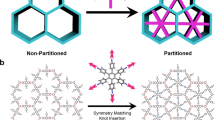Abstract
Covalent organic frameworks (COFs) are porous crystalline materials composed of light elements linked by strong covalent bonds. A number of these materials contain a high density of Lewis acid boron sites that can strongly interact with Lewis basic guests, which makes them ideal for the storage of corrosive chemicals such as ammonia. We found that a member of the covalent organic framework family, COF-10, shows the highest uptake capacity (15 mol kg−1, 298 K, 1 bar) of any porous material, including microporous 13X zeolite (9 mol kg−1), Amberlyst 15 (11 mol kg−1) and mesoporous silica, MCM-41 (7.9 mol kg−1). Notably, ammonia can be removed from the pores of COF-10 by heating samples at 200 °C under vacuum. In addition, repeated adsorption of ammonia into COF-10 causes a shift in the interlayer packing, which reduces its apparent surface area to nitrogen. However, owing to the strong Lewis acid–base interactions, the total uptake capacity of ammonia and the structural integrity of the COF are maintained after several cycles of adsorption/desorption.
This is a preview of subscription content, access via your institution
Access options
Subscribe to this journal
Receive 12 print issues and online access
$259.00 per year
only $21.58 per issue
Buy this article
- Purchase on Springer Link
- Instant access to full article PDF
Prices may be subject to local taxes which are calculated during checkout





Similar content being viewed by others
References
Côté, A. P. et al. Porous, crystalline, covalent organic frameworks. Science 310, 1166–1170 (2005).
El-Kaderi, H. M. et al. Designed synthesis of 3D covalent organic frameworks. Science 316, 268–272 (2007).
Côté, A. P., El-Kaderi, H. M., Furukawa, H., Hunt, J. R. & Yaghi, O. M. Reticular synthesis of microporous and mesoporous 2D covalent organic frameworks. J. Am. Chem. Soc. 129, 12914–12915 (2007).
Tilford, R. W., Gemmil, W. R., zur Loye, H.-C. & Lavigne, J. J. Facile synthesis of a highly crystalline, covalently linked porous boronate network. Chem. Mater. 18, 5296–5301 (2006).
Tilford, R. W., Mugavero, S. J., Pellechia, P. J. & Lavigne, J. J. Tailoring microporosity in covalent organic frameworks. Adv. Mater. 20, 2741–2746 (2008).
Hunt, J. R., Doonan, C. J., LeVangie, J. D., Côté, A. P. & Yaghi, O. M. Reticular synthesis of covalent organic borosilicate frameworks. J. Am. Chem. Soc. 130, 11872–11873 (2008).
Stephens, F. H., Pons, V. & Baker, R. T. Ammonia–borane, the hydrogen storage source par excellence. Dalton Trans. 2613–2626 (2007).
O'Keeffe, M., Peskov, M. A., Ramsden, S. J. & Yaghi, O. M. The Reticular Chemistry Structure Resource (RCSR) database of, and symbols for, crystal nets. Acc. Chem. Res. 41, 1782–1789 (2008).
Roquerol, F., Rouquerol, J. & Sing, K. Adsorption by Powders and Porous Solids (Academic Press, 1999).
Helminen, J., Helenius, J. & Paatero, E. Adsorption equilibria of ammonia gas on inorganic and organic sorbents at 298.15 K. J. Chem. Eng. Data 46, 391–399 (2001).
Barrer, R. M. Clay minerals as selective and shape-selective sorbents. Pure Appl. Chem. 61, 1903–1912 (1989).
Adu, K. W. et al. Morphological, structural, and chemical effects in response of novel carbide derived carbon sensor to NH3, N2O, and air. Langmuir 25, 582–588 (2009).
Seredych, M. & Bandosz, T. J. Adsorption of ammonia on graphite oxide/aluminium polycation and graphite oxide/zirconium–aluminium polyoxycation composites. J. Colloid Interface Sci. 324, 25–35 (2008).
Klerke, A., Christensen, C. H., Norskov, J. K. & Vegge, T. Ammonia for hydrogen storage: challenges and opportunities. J. Mater. Chem. 18, 2304–2310 (2008).
Christensen, C. H., Johannessen, T., Sorensen, R. Z. & Norskov, J. K. Towards an ammonia-mediated hydrogen economy? Catal. Today 111, 140–144 (2006).
Gusev, V. Y., Feng, X., Bu, Z., Haller, G. L. & O'Brien, J. A. Mechanical stability of pure silica mesoporous MCM-41 by nitrogen adsorption and small-angle X-ray diffraction measurements. J. Phys. Chem. 100, 1985–1988 (1996).
Bai, N., Chi, Y., Zou, Y. & Pang, W. Influence of high pressure on structural property of mesoporous material MCM-41: study of mechanical stability. Mater. Lett. 54, 37–42 (2002).
Acknowledgements
Funding was provided by the Department of Energy (DOE) (DEFG0208ER15935) for adsorption studies and Department of Defense (DOD) (W911NF-06-1-0405) for adsorption equipment.
Author information
Authors and Affiliations
Contributions
C.J.D and O.M.Y conceived and designed the experiments. All authors contributed significantly and collaboratively to performing the experiments, analysing the data and writing the paper.
Corresponding author
Ethics declarations
Competing interests
The authors declare no competing financial interests.
Supplementary information
Supplementary information
Supplementary information (PDF 988 kb)
Rights and permissions
About this article
Cite this article
Doonan, C., Tranchemontagne, D., Glover, T. et al. Exceptional ammonia uptake by a covalent organic framework. Nature Chem 2, 235–238 (2010). https://doi.org/10.1038/nchem.548
Received:
Accepted:
Published:
Issue Date:
DOI: https://doi.org/10.1038/nchem.548
This article is cited by
-
Metal-free 2-isocyanobiaryl-based cyclization reactions: phenanthridine framework synthesis
Molecular Diversity (2024)
-
Efficient capture and storage of ammonia in robust aluminium-based metal-organic frameworks
Communications Chemistry (2023)
-
Porous organic polymers: a progress report in China
Science China Chemistry (2023)
-
Construction of a Three-dimensional Covalent Organic Framework via the Linker Exchange Strategy
Chemical Research in Chinese Universities (2022)
-
Cooperation between covalent organic frameworks (COFs) and metal organic frameworks (MOFs): application of COFs-MOFs hybrids
Advanced Composites and Hybrid Materials (2022)



